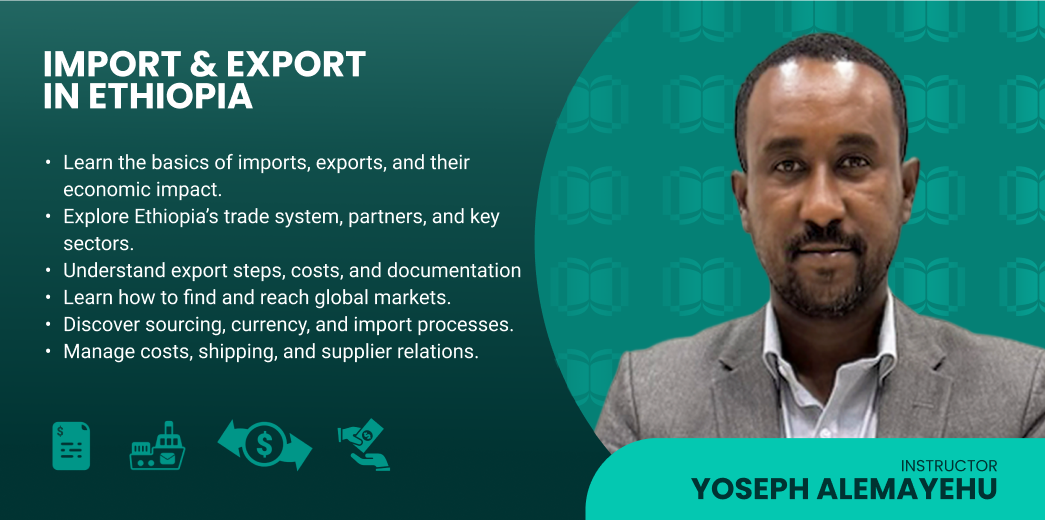Practical Import and Export Operation

#Business
In Partnership With

About the Course
This course is designed to equip trainees with the essential know-how and understanding of the concepts, guiding principles, and, most importantly, the practical and real operational tendencies of various stakeholders within the import/export sector. It aims to enable trainees to better understand the economic factors that significantly impact their day-to-day lives, while also providing them with a platform to pursue their entrepreneurial aspirations. Understanding the factors, stakeholder activities, policies, and practices of this sector is critical for individuals living in the country, as neglecting them can be financially detrimental. Therefore, this course offers an opportunity for trainees to gain a solid understanding of the landscape and, hopefully, inspire them to delve deeper to identify and create opportunities for themselves.
Trainee Qualification Requirements and Prerequisites
This course requires no prior education or professional undertaking. However, individuals with a business-savvy mindset are considered most beneficial. Displays, computers, and internet access will be required at certain stages of this course.
Training Delivery
The sessions are designed to be most useful when conducted using a participatory approach, encouraging trainees to raise points and questions at any stage of the session, which is not only welcomed but rewarded.
Training Level
This course is suitable for a diverse target group, including young job seekers interested in the import and export business, entrepreneurs, startup companies, logistics enthusiasts, and professionals from other sectors looking to broaden their horizons. Upon completion, trainees are expected to achieve an "about-average" understanding of the import/export landscape and be able to manage import/export operations with minimal guidance, suggesting it's designed to bring participants to a competent operational level.
Lesson Activities
Learning in this course is fostered through a participatory approach, where raising points and questions during sessions is encouraged and rewarded. The requirement for displays, computers, and internet access indicates practical, potentially hands-on activities are part of the learning process.
Training Objective
At the end of this course, trainees will be able to:
- Have an about-average understanding of the import/export layout.
- Foresee potential challenges in real import and export processes.
- Manage import/export operations with minimal guidance.
- Have insight into the factors that have a real financial impact on their day-to-day lives.
Training Subject Areas
This course is structured into three main chapters:
Chapter 1: Introduction: This chapter introduces the fundamentals of international trade, defining imports and exports and their roles in economic systems. It explores economic factors influencing imports, such as free trade agreements and tariffs, and debates the positive and negative impacts of imports on domestic industries and consumers. The chapter also explains how companies measure net exports and the contribution of exports to a country’s GDP. Additionally, it provides an overview of Ethiopia’s trade economy, highlighting its rapid growth, GDP scale, key trading partners, major sectors like agriculture and services, and top import categories.
Chapter 2: Export Operation: This chapter outlines the operational aspects of exporting from Ethiopia, covering purchasing commodities through the Ethiopian Commodity Exchange (ECX) or vertical integration, including associated processes and challenges. It details post-contract steps like processing and documentation, cost aggregation (e.g., booking confirmation, permits, inspections), and payment and shipping terms, including International Commercial Terms. The chapter also discusses strategies for identifying export markets, such as leveraging local representatives, market research, Google searches, and trade shows.
Chapter 3: Import Operation: This chapter focuses on the import process in Ethiopia, addressing key considerations for importers, particularly for reselling, such as identifying what to import, sourcing suppliers, and target markets. It describes methods for finding and verifying suppliers through online platforms, international expos, and local chambers of commerce. The chapter explains foreign currency acquisition via export proceeds or transfers, import processing through the Ethiopian Single Window system (including documentation, permits, and customs clearance), cost build-up, and payment and shipping terms applicable to imports.
Assessment and Evaluation
Trainees will be assessed based on a weighted evaluation system:
- Continuous assessment: 40%
- Test: 40%
- Assignment: 15%
- Class Activity: 5%
- Total: 100% Attendance is non-negotiable, with trainees requiring at least 80% attendance to be awarded a certificate.
Who should learn this course?
- Young job seekers looking to explore the import and export business
- Entrepreneurs
- Startup companies
- Logistics enthusiasts
- Professionals in other sectors looking to broaden their horizon
What you will learn?
- How to manage import/export operations with minimal guidance
- Insight into factors that have a real financial impact on day-to-day lives
- Know-how and understanding of concepts, guiding principles, and practical operation tendencies of various stakeholders in the import/export sector
- To better understand economic factors influencing daily lives
- A decent understanding of the sector's landscape to create opportunities
What is required to learn this course?
- No prior education or professional undertaking
- A business-savvy mindset is beneficial
- Desire to gain the appropriate knowledge in the Import and Export Business
Schedule
Weekday
Weekend
Curriculum
Course Reviews

There are no Reviews available for this course yet!

